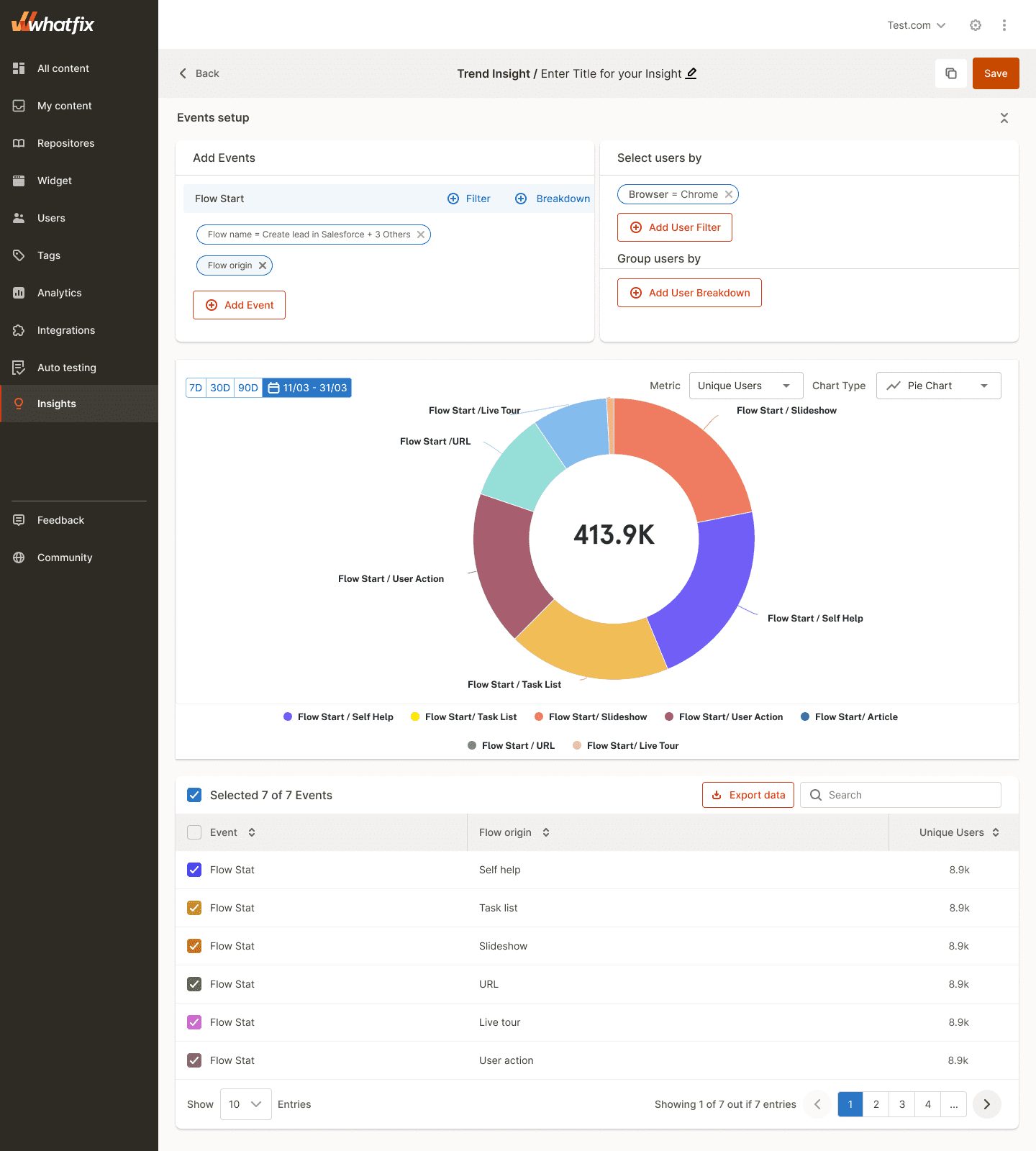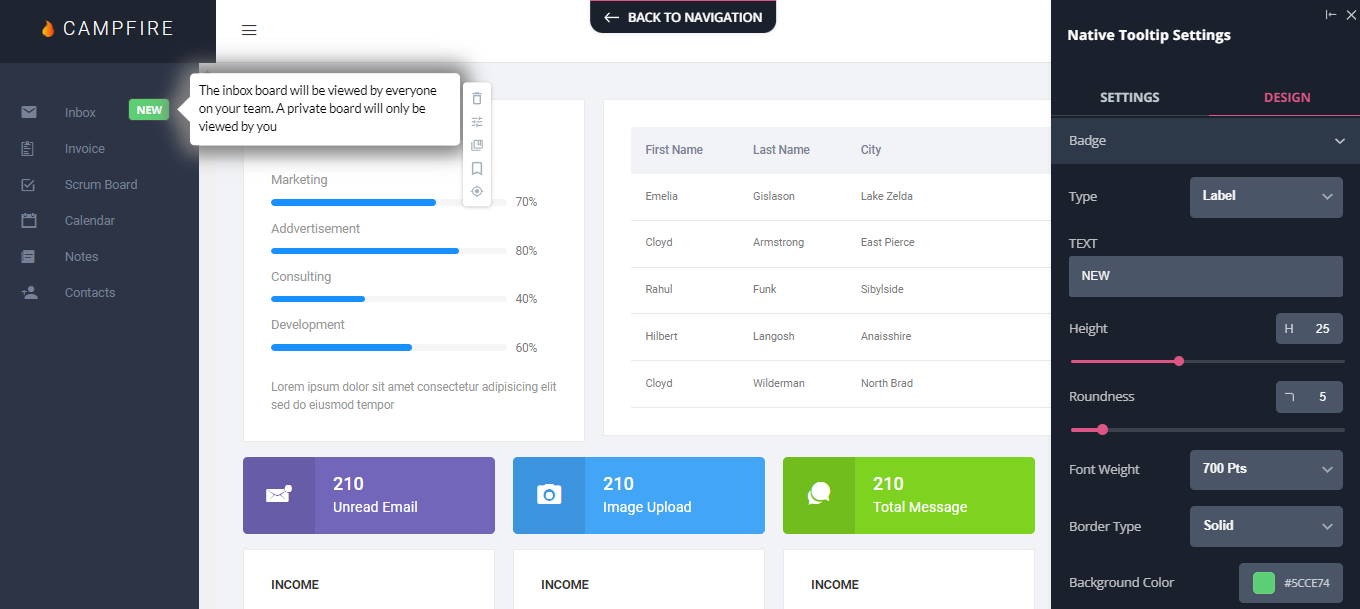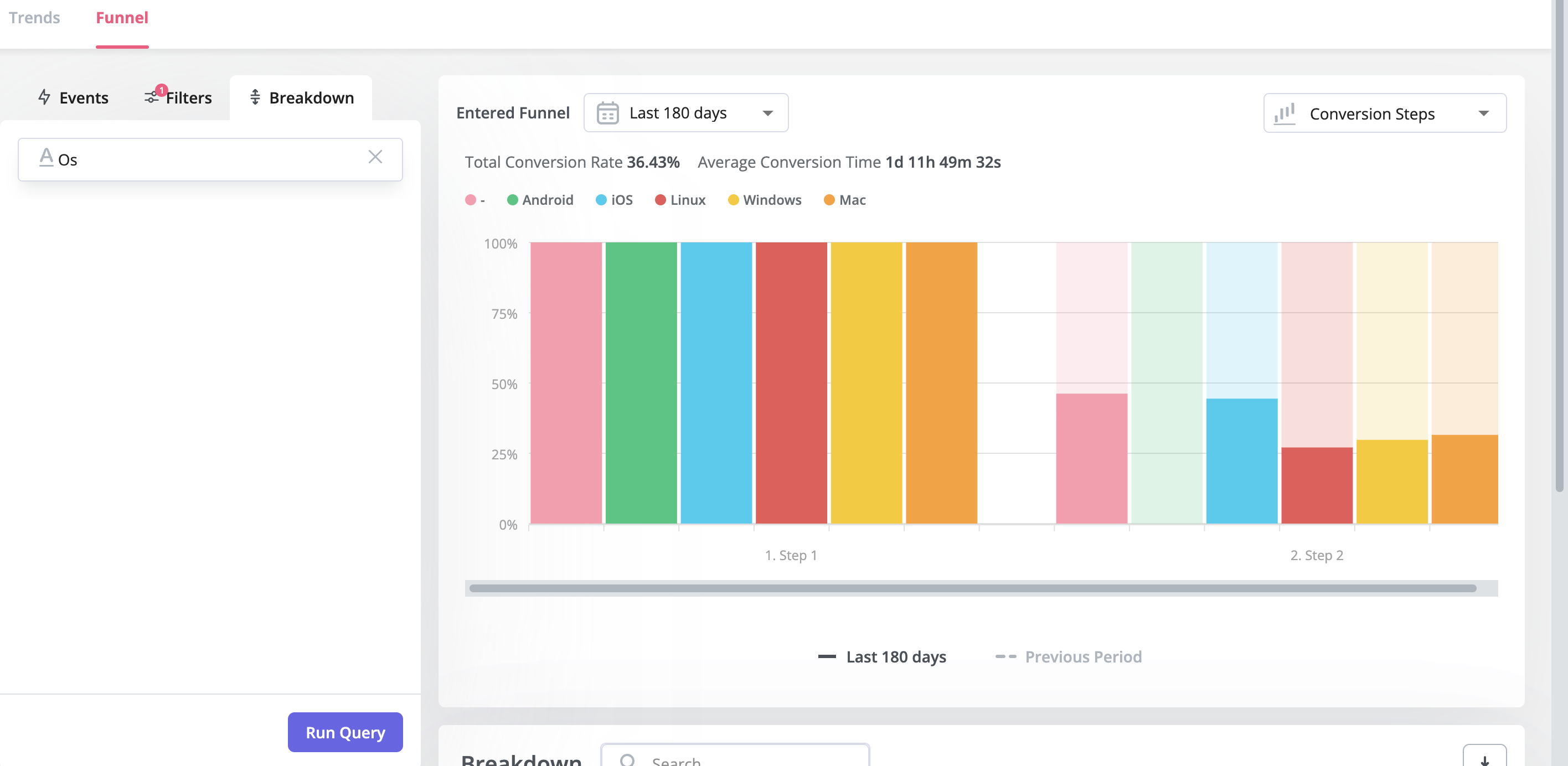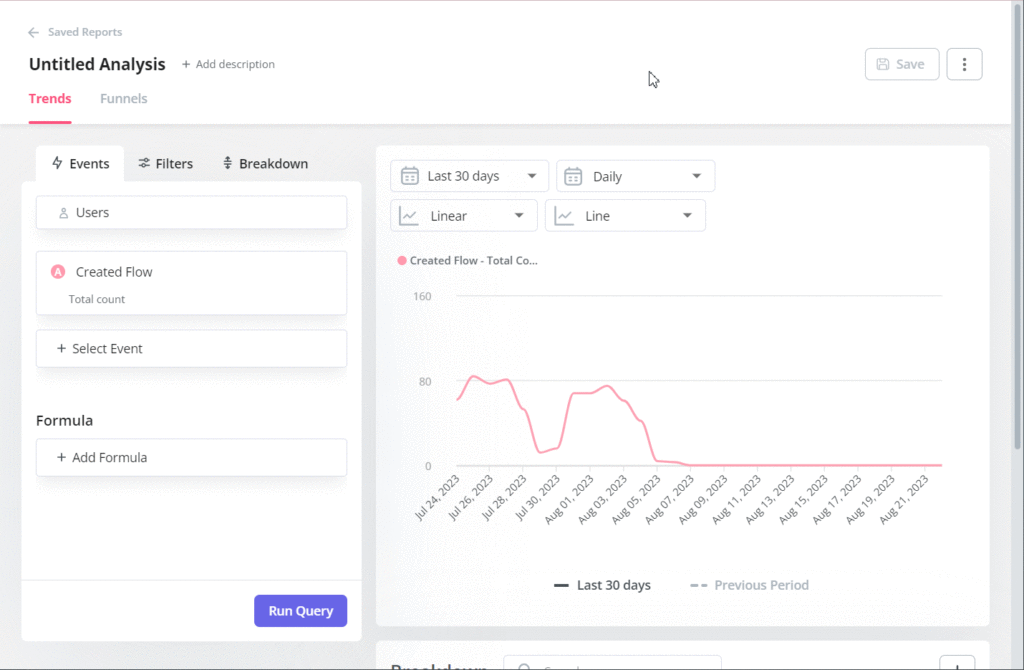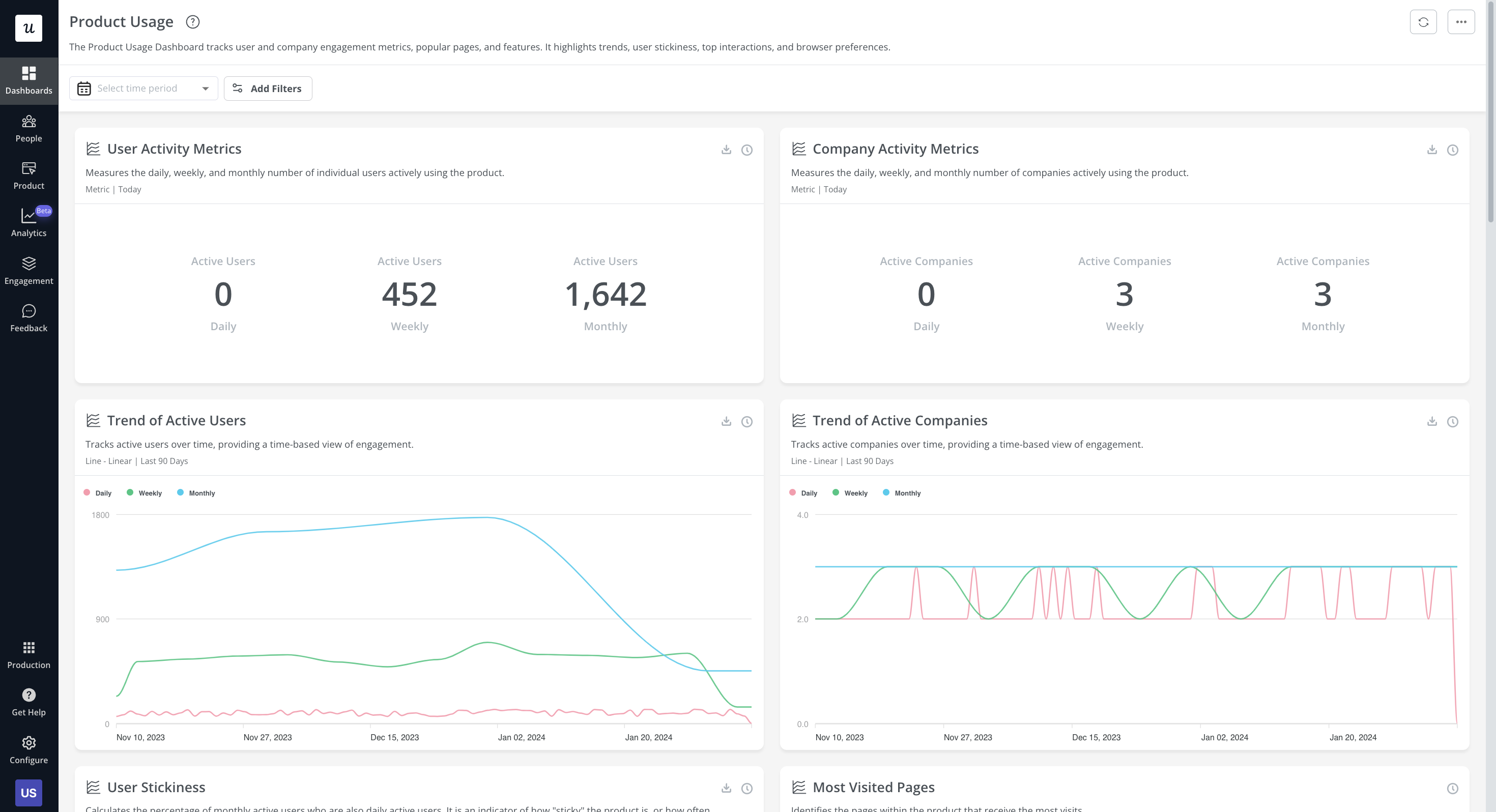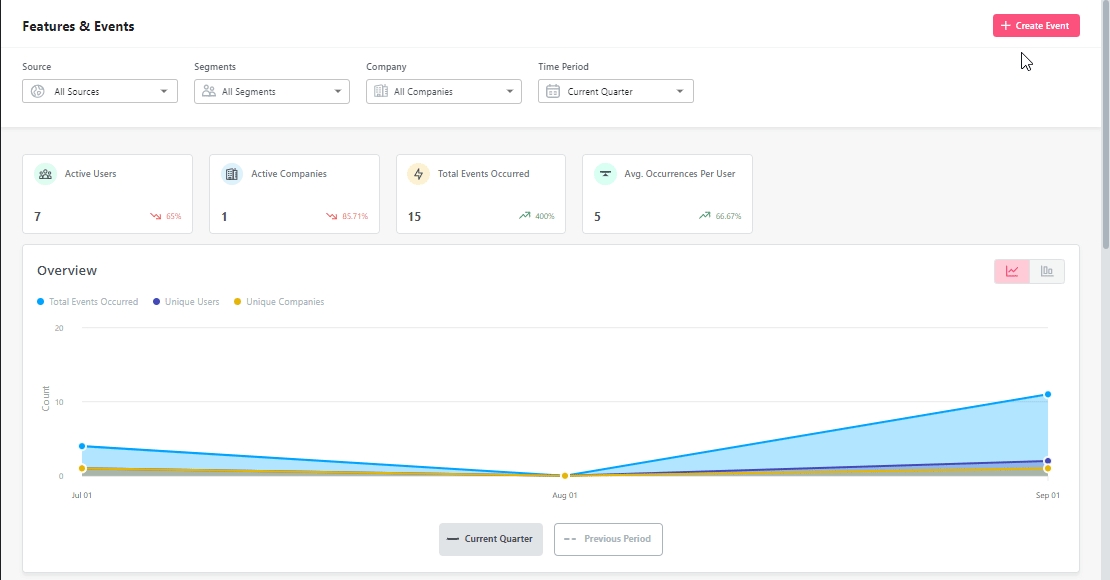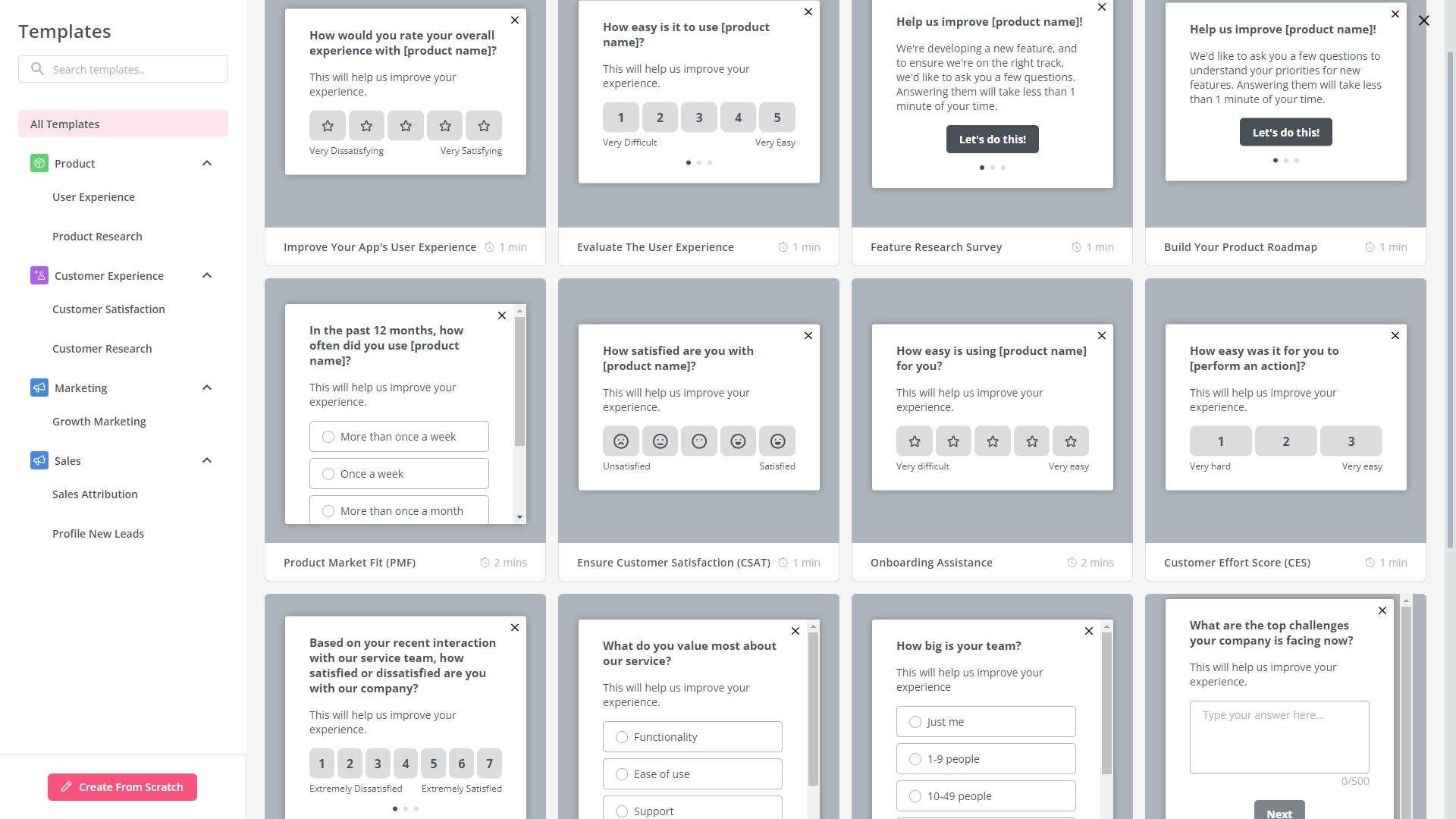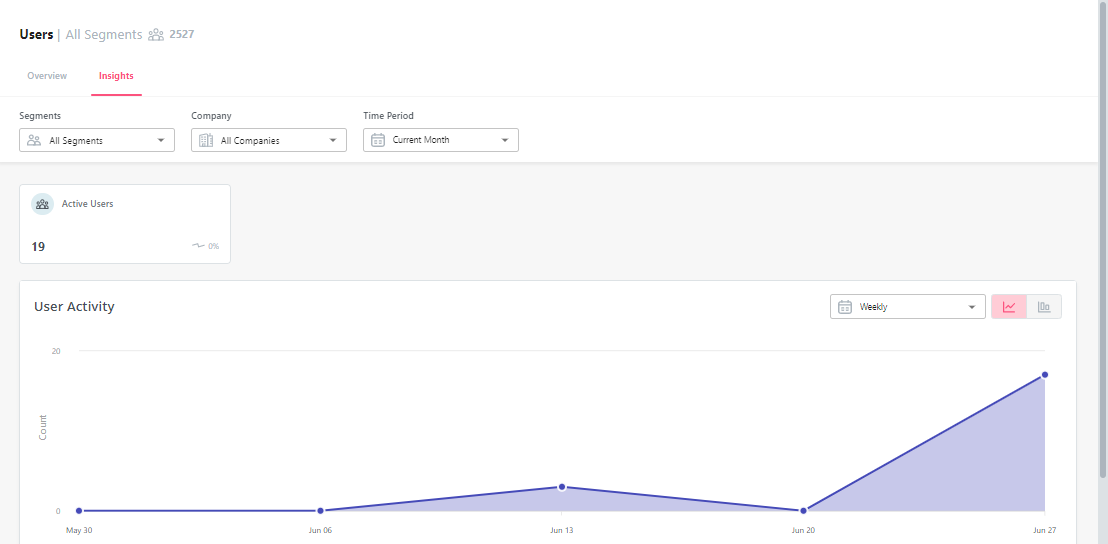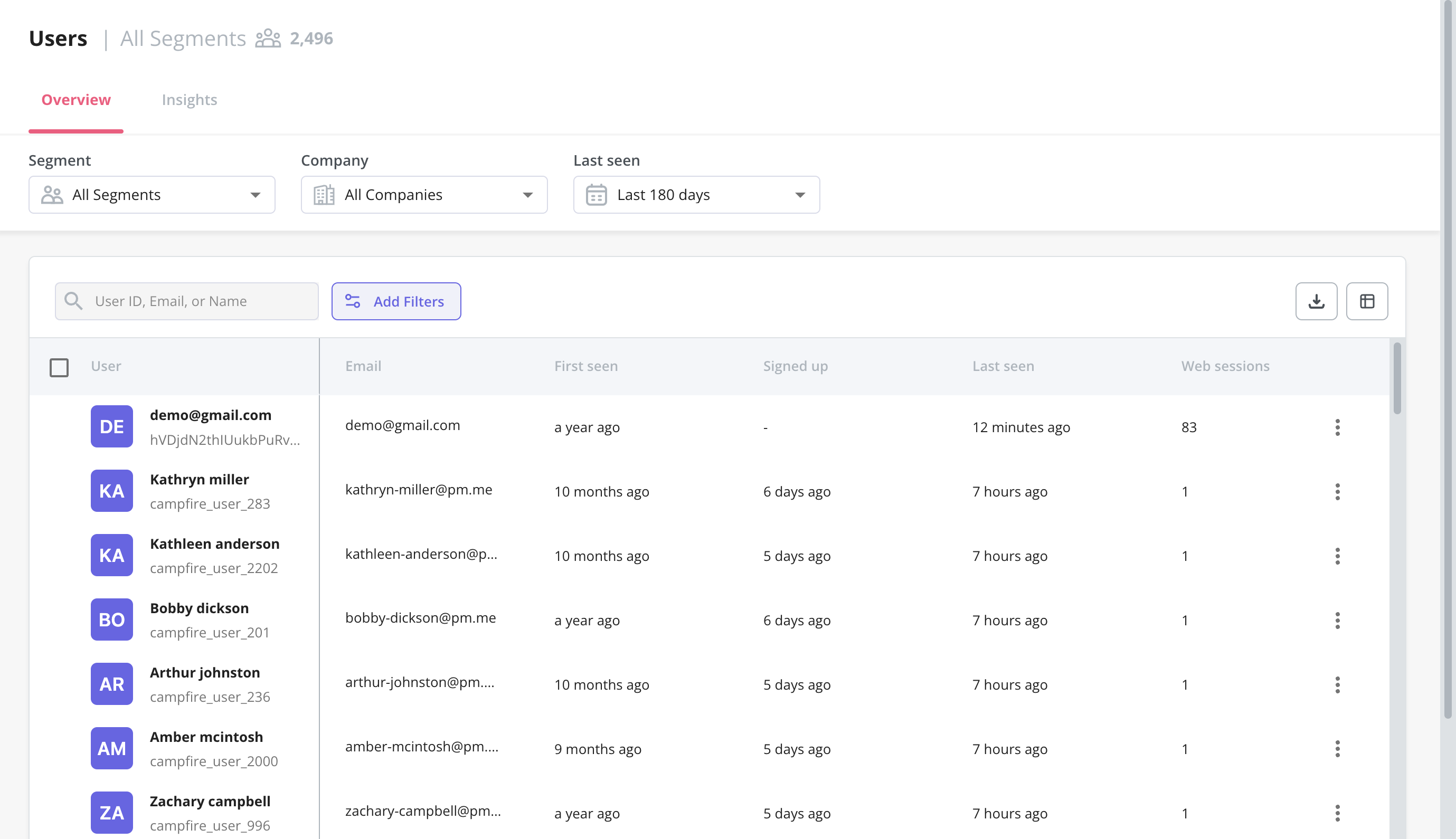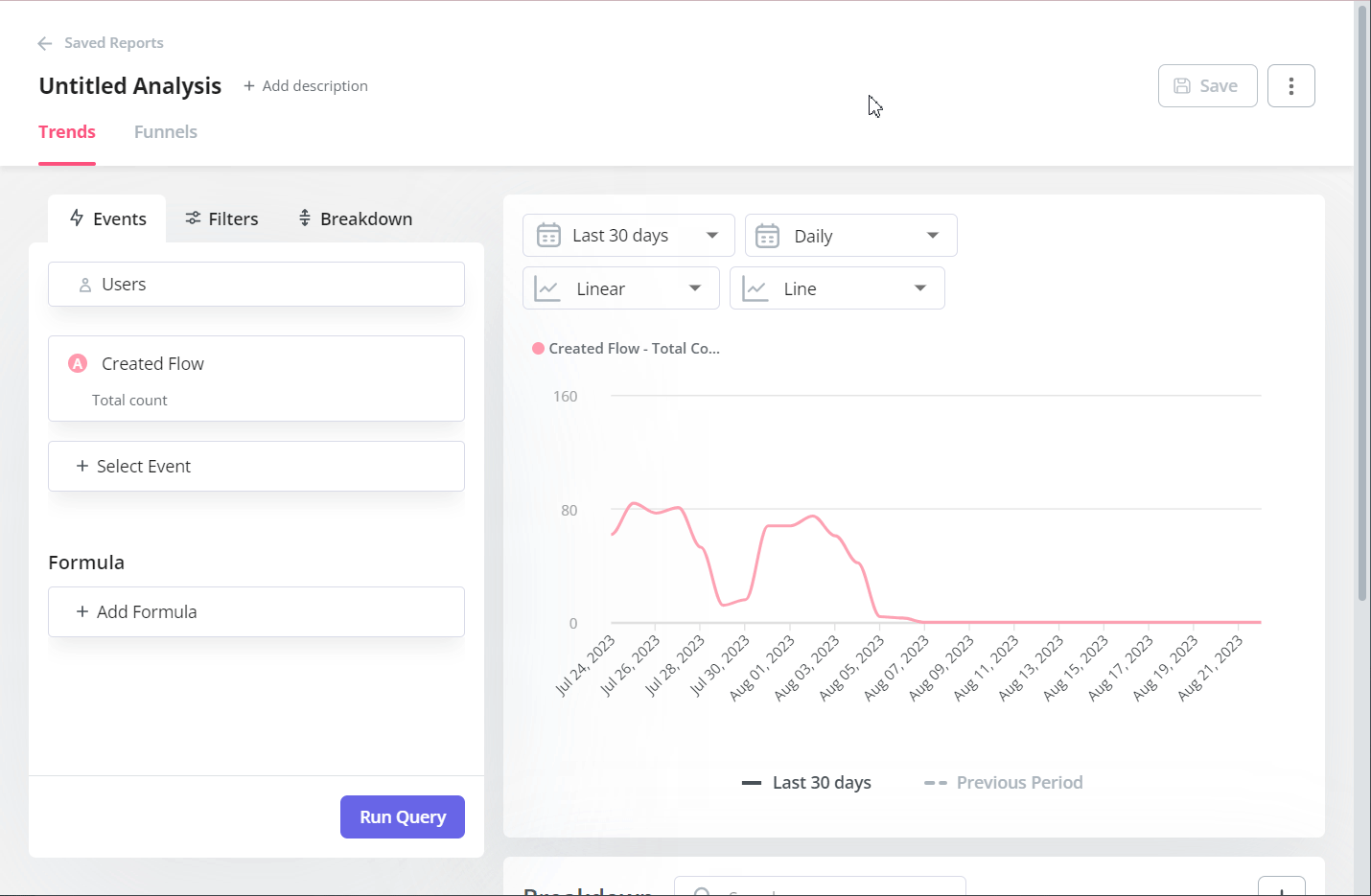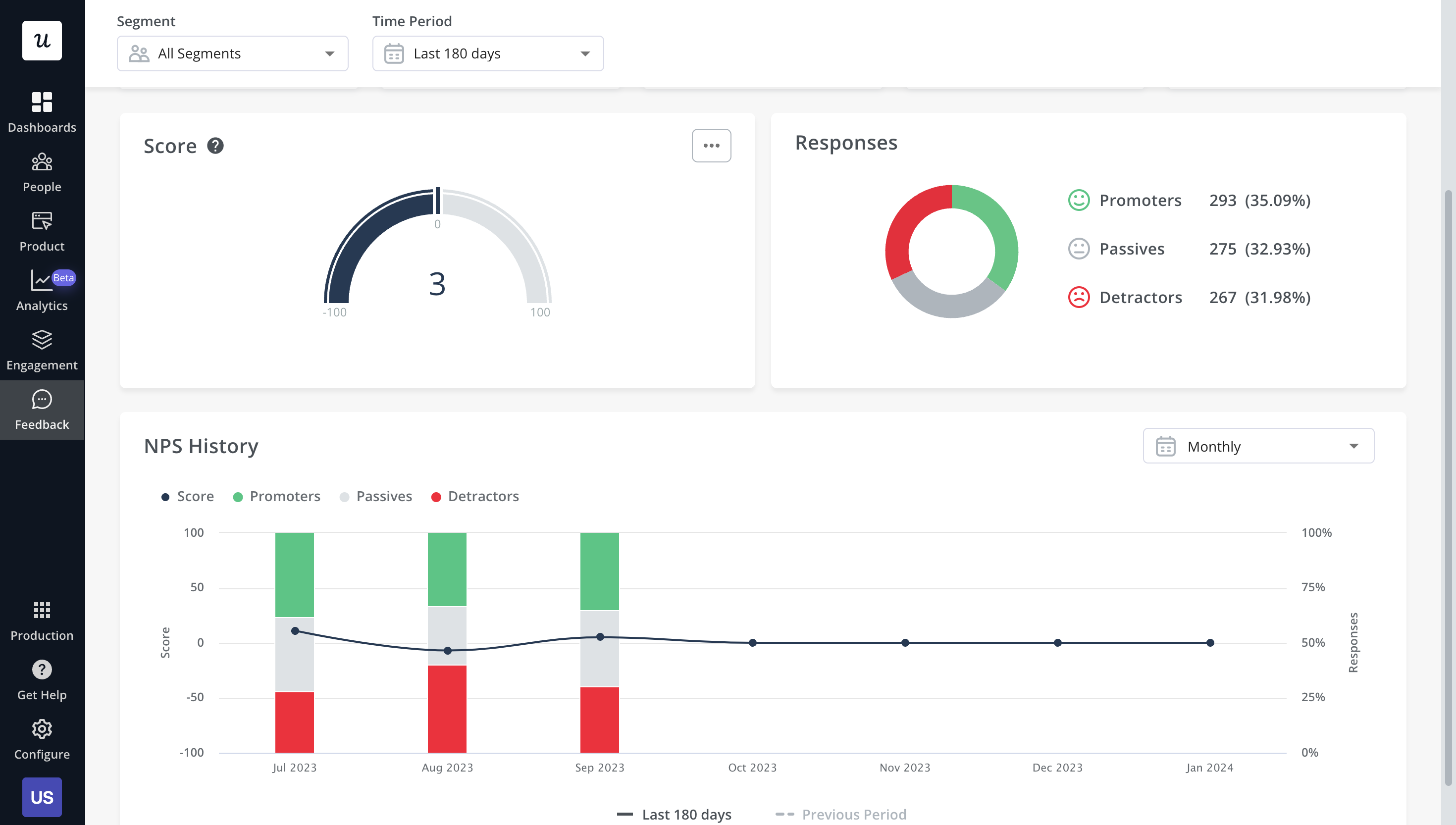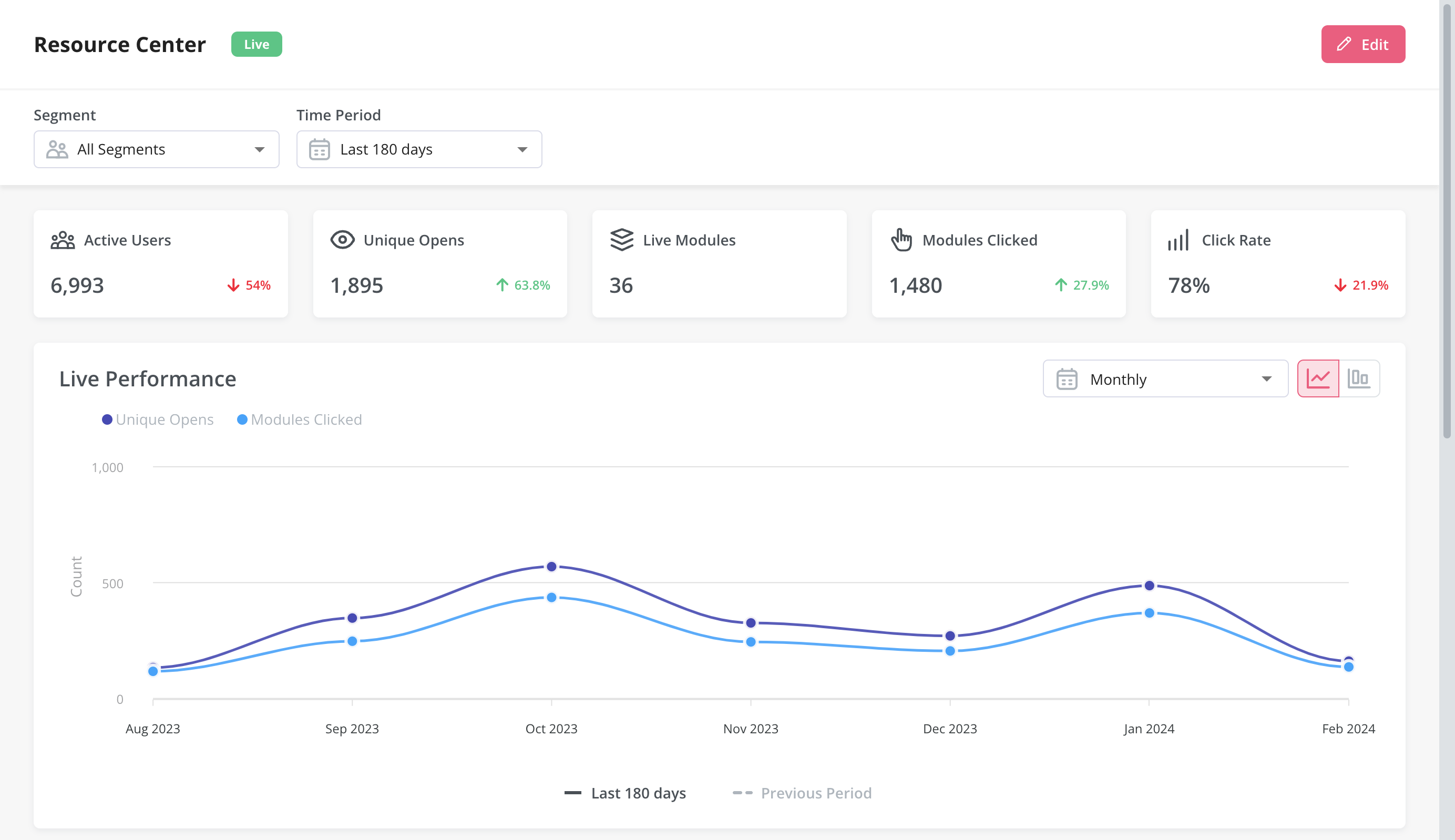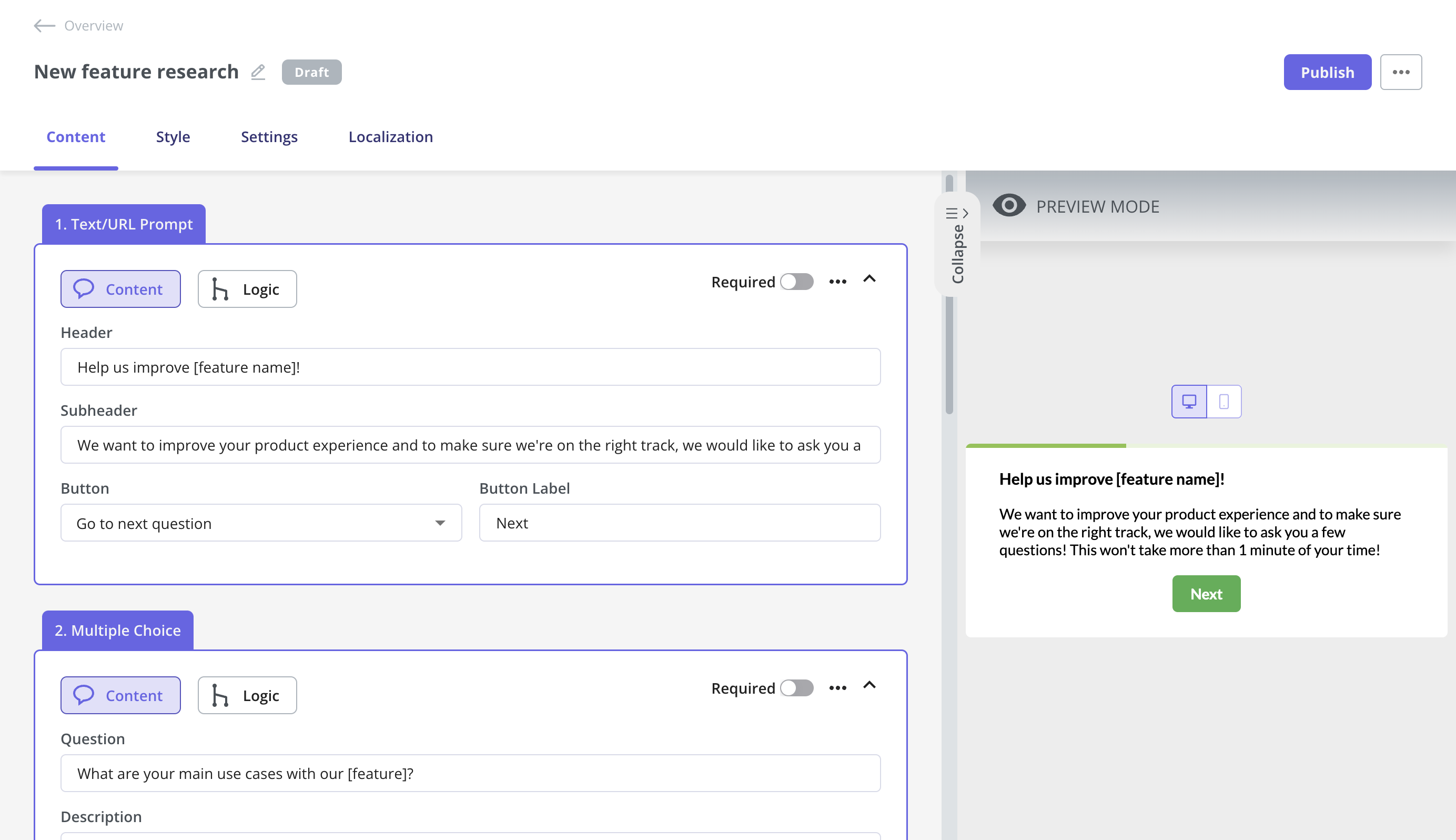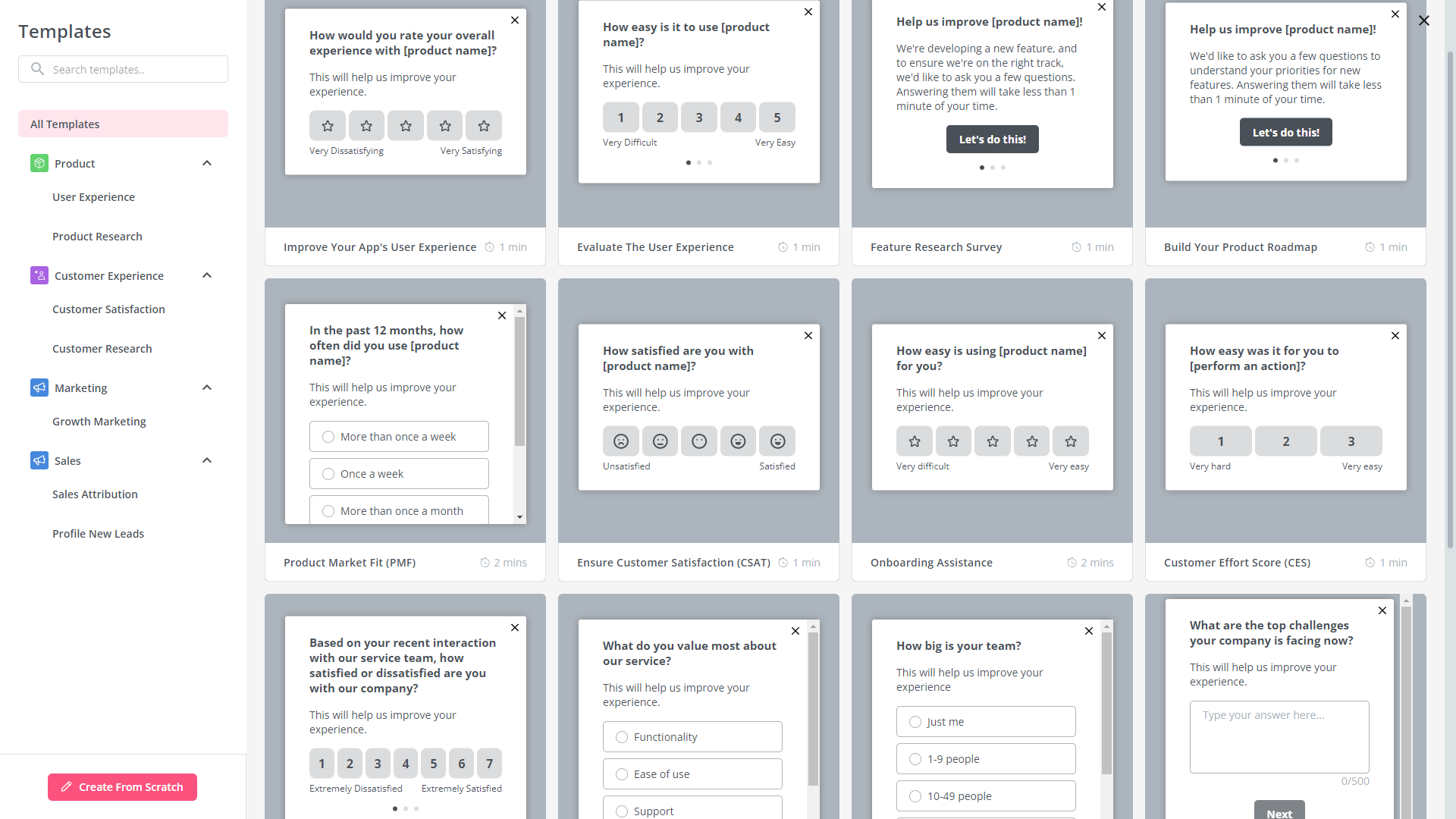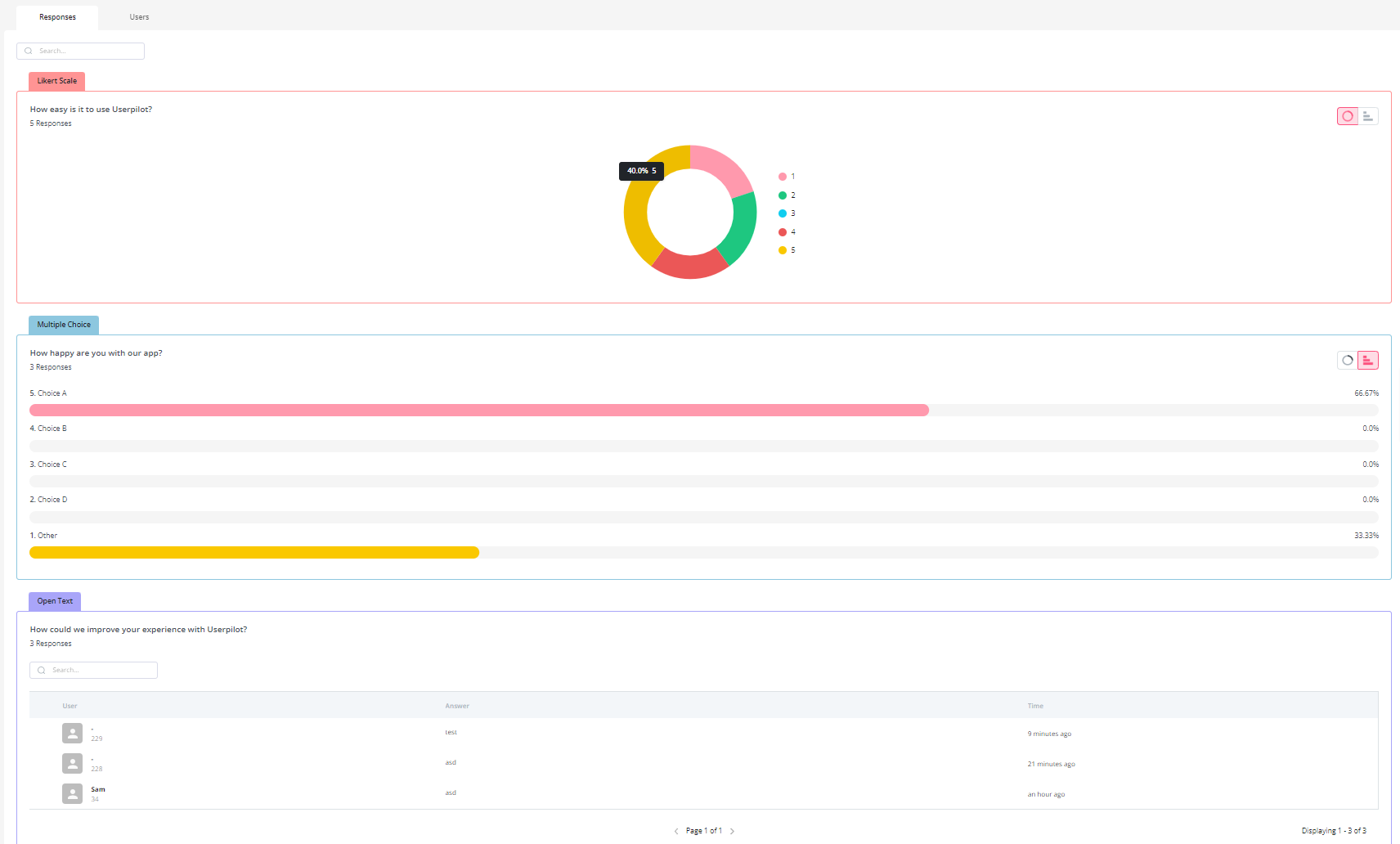
Wondering whether Userpilot or Whatfix is the best option for your SaaS company?
This article is going to dive into the Userpilot vs Whatfix debate and try to answer a key question: Which is the better tool for user onboarding, as well as other use cases?
In the post below, we’ve covered all the common use cases and done an in-depth analysis of the key features of Userpilot and Whatfix – as well as explaining which one is better in certain cases.
Let’s get into it!
Try Userpilot Now
See Why 1,000+ Teams Choose Userpilot

Userpilot vs Whatfix (Summary)
- Let’s explore how Userpilot, and Whatfix compare when it comes to user onboarding and other common use cases.
- Userpilot is a product growth platform that drives user activation, feature adoption, and expansion revenue. It also helps product teams collect user feedback, streamline onboarding, and gather actionable insights from analytics.
- Whatfix is a digital adoption platform that helps enterprise organizations with onboarding, training, and supporting their employees or customers. It accomplishes this through in-app guidance and messaging to provide on-demand support whenever it’s needed.
- However, in certain situations, Userpilot can’t be used to onboard employees to internal software but it does have a few notable advantages over Whatfix:
- Userpilot has a diverse array of UI patterns and native features that make its no-code flows the most effective form of in-app guidance. You can use modals, banners, tooltips, hotspots, and other patterns to create advanced in-app flows.
- Userpilot’s advanced analytics capabilities allow you to generate various reports. These reports can show you data trends, help you conduct funnel analysis, highlight the paths your users take, and display retention data for different cohorts.
- While Whatfix does offer surveys, Userpilot surveys are more flexible and come with 14 templates to choose from. You’ll also be able to run NPS surveys that send all data to the NPS dashboard and automatically show you how scores (or related metrics) change over time.
What is Userpilot?
Userpilot is a product growth platform that drives user activation, feature adoption, and expansion revenue. It also helps product teams collect user feedback, streamline onboarding, and gather actionable insights from analytics.
With Userpilot, you’ll be able to track both product usage and user behavior to get a holistic view of how customers use your product — which will guide future development, improve the user experience, and inform your growth efforts.
What is Whatfix?
Whatfix is a digital adoption platform that helps enterprise organizations with onboarding, training, and supporting their employees or customers. It accomplishes this through in-app guidance and messaging to provide on-demand support whenever it’s needed.
The solution also lets you track analytics on all in-app guidance, collect user feedback, build out self-serve content, and automate certain flows. Whatfix even has integrations with Salesforce, Amplitude, Google Analytics, Slack, Confluence, and other platforms to maximize collaboration.
Userpilot vs Whatfix for user onboarding
In this section of the article, we’re really going to compare Userpilot vs Whatfix in terms of user onboarding. That way, we’ll be able to figure out which tool – Userpilot or Whatfix – is the best option depending on your use case.
Userpilot for user onboarding
User onboarding is a crucial part of the customer journey as it speeds up the adoption process and increases retention rates. Onboarding is one of Userpilot’s core use cases along with product growth analytics and user feedback, so it has plenty of features that you can utilize.
Here are some Userpilot features you can use when onboarding new users:
- No-code builder: Creating flows with Userpilot is as simple as installing the Chrome extension, selecting the UI patterns you’d like to use, and then editing the content/settings to suit your use case. You can also use templates to create modals, slideouts, tooltips, and driven actions.
- Native tooltips: Userpilot lets you create native tooltips that show up when users hover over an element or click on an information badge. Since these native tooltips attach to the element itself, they aren’t page-dependent and will show up on any screen where that element is visible.
- Funnel analytics: Userpilot’s advanced analytics lets you create funnel reports that track the onboarding journey. You can also add filters (like name, user ID, signup date, operating system, country, etc.) and monitor the total conversion rate from the first step of the funnel to the last.
- User segmentation: Userpilot lets you segment users based on the device they’re using, where they’re located, their engagement data, or which NPS rating they selected on the latest survey. You can then filter your analytics dashboards to see which segments struggle with onboarding.
Whatfix for user onboarding
User onboarding is a complex process that only the most flexible tools can pull off. Whatfix has its fair share of bugs and technical quirks but there are a few features that bolster its onboarding capabilities — namely its tours, checklists, and integrations.
Here’s an overview of Whatfix’s onboarding features:
- Whatfix lets you create interactive product tours for both users and employees. This reduces the time to value (TTV), whether it’s for customers using your product or employees learning how to use a solution in the internal tool stack.
- Onboarding checklists (known as task lists on Whatfix) give new users or employees a clear next step on their journey toward product adoption. Whatfix lets you create these checklists as widgets target specific segments, and group tasks under headers.
- Whatfix’s gallery of direct integrations with tools like Salesforce, Amplitude, SurveyMonkey, and more helps you centralize all onboarding data. The onboarding metrics gathered and synced across tools can then help you streamline your in-app flows.
Userpilot vs Whatfix for product adoption
In this section of the article, we’re really going to compare Userpilot vs Whatfix in terms of product adoption. That way, we’ll be able to figure out which tool – Userpilot or Whatfix – is the best option depending on your use case.
Userpilot for product adoption
Product adoption is when users become repeat users of your product. It covers the entire journey spanning from the awareness stage to trial signup and finally full-on adoption. As a product growth platform, Userpilot has advanced analytics capabilities for tracking adoption over time.
Here are the Userpilot features that can help you measure and improve product adoption:
- Product analytics: Userpilot lets you create trend reports to track adoption over time by feature or segment, funnel reports that show you which steps of the process most users get stuck on, and integrations with third-party analytics providers so you can sync data between tools.
- Product usage dashboard: It collects all your key product usage metrics automatically without you having to set anything up: your Daily, Monthly, and Weekly Active Users and Companies, Trends of Active Users and Companies over time, user stickiness, top pages, features, and events, as well as the most engaged users, highest user activity times throughout the day, user retention, average session duration and product usage by browser.
- Feature engagement: Userpilot’s click-to-track feature tagger lets you see how often a feature is used and by how many people. You’ll also be able to see the top 20 events for a certain time period or create custom events that group multiple features together for clearer insights.
- Feedback collection: Userpilot has a no-code survey builder with 14 templates to choose from. You’ll be able to collect quantitative data like CSAT, CES, or NPS ratings and qualitative feedback on the strongest/weakest parts of your product straight from your users.
- User insights: The Insights dashboard lets you monitor user activity based on which segment they’re in and which company they’re from. You’ll also be able to choose from daily, weekly, and monthly time periods to see if user activity is shifting towards full product adoption over time.
Whatfix for product adoption
User onboarding is a complex process that only the most flexible tools can pull off. Whatfix has its fair share of bugs and technical quirks but there are a few features that bolster its onboarding capabilities — namely its tours, checklists, and integrations.
Here’s an overview of Whatfix’s onboarding features:
- Whatfix lets you create interactive product tours for both users and employees. This reduces the time to value (TTV), whether it’s for customers using your product or employees learning how to use a solution in the internal tool stack.
- Onboarding checklists (known as task lists on Whatfix) give new users or employees a clear next step on their journey toward product adoption. Whatfix lets you create these checklists as widgets target specific segments, and group tasks under headers.
- Whatfix’s gallery of direct integrations with tools like Salesforce, Amplitude, SurveyMonkey, and more helps you centralize all onboarding data. The onboarding metrics gathered and synced across tools can then help you streamline your in-app flows.
Userpilot vs Whatfix for customer experience
In this section of the article, we’re really going to compare Userpilot vs Whatfix in terms of customer experience. That way, we’ll be able to figure out which tool – Userpilot or Whatfix – is the best option depending on your use case.
Userpilot for customer experience
Userpilot gives you an eagle-eye view of the customer experience through user analytics, trend/funnel reports, and feedback collection through different types of surveys.
Here’s how you can use Userpilot to track and analyze customer experience insights:
- User analytics: The users dashboard gives you an overview of all your users while letting you sort by segment, company, or when they were last seen. You can also export user data in bulk as a CSV or click on the Insights tab to see segment-specific insights for a given time period.
- Trends and funnels: Userpilot’s trends and funnels reports let you track certain events like a specific feature’s usage, add filters to narrow down the data, and then create a breakdown based on segmentation data or user attributes — offering quick and actionable CX reports.
- Satisfaction benchmarking: Userpilot has a built-in NPS dashboard that tracks customer loyalty over time. In addition to the NPS dashboard, you can also use Userpilot’s survey templates to run CSAT or CES surveys and gather additional quantitative and qualitative insights on the customer experience.
- Self-service support: Userpilot lets you build in-app resource centers, which can include feedback widgets to collect feedback passively, checklists to walk users through specific processes, or integrations with knowledge bases to leverage existing documentation.
- In-app flows: Userpilot’s no-code flow builder helps you create product experiences that can help you optimize the customer experience by educating customers and reducing their time-to-value (TTV). All UI patterns are available on every Userpilot plan from Starter to Enterprise.
Whatfix for customer experience
Customer experience insights are imperative for understanding how people use your product. Whatfix can be used to improve the product experience both for customers as well as your employees using internal software.
Here are the Whatfix features you can use to improve the customer experience:
- You can collect feedback from your customers or employees while they’re actively using a software application. These input fields can be used to collect feedback on the customer experience or specific aspects of the product.
- Ask scalar, multiple choice, and open-ended questions to get an accurate view of net promoter scores (as well as the driving forces behind each rating). Note that you’ll only be able to edit, delete, or reorder questions if you upgrade to Premium.
- Adding tooltips, hotspots, and beacons on top of a piece of software using Whatfix can draw attention toward specific features. Whatfix tooltips are particularly helpful because they expand when hovered over and provide additional information to users.
Userpilot vs Whatfix for user feedback
In this section of the article, we’re really going to compare Userpilot vs Whatfix in terms of user feedback. That way, we’ll be able to figure out which tool – Userpilot or Whatfix – is the best option depending on your use case.
Userpilot for user feedback
User feedback is an essential part of listening to the Voice of the Customer (VoC) and making product development or marketing decisions that best suit your customer base. Userpilot has a no-code survey builder, 14 templates to choose from, and advanced analytics for extracting insights.
Here are the Userpilot features you can use to collect customer feedback and analyze it:
- Survey builder: Userpilot’s survey builder lets you edit the content, update the widget’s style/placement, and set page-specific or event-specific triggers to ensure that users see the survey at the most contextual moment — all without writing a single line of code. You can also translate surveys into your audience’s native language.
- Survey templates: There are 14 survey templates to choose from with a wide array of different use cases. You can collect qualitative responses on how to improve the user/product experience or quantitative data for customer satisfaction benchmarking such as CSAT and CES scores.
- Advanced analytics: Userpilot’s advanced survey analytics will show you what the most common responses were, what percentage of users selected a specific option, and display open-ended feedback about your product or specific features.
- NPS dashboard: Userpilot’s NPS dashboard compiles response data from all NPS surveys so you don’t have to manually go into each survey and check its analytics. You’ll be able to view key metrics like response rates, total views, and NPS history and sort all the data by different segments.
Whatfix for user feedback
User feedback is essential to gather data on how customers or employees interact with a particular tool and which challenges they might face while doing so. Whatfix has surveys, NPS surveys, and feedback forms that give your users a voice.
Here’s how you can use Whatfix to collect customer feedback:
- Whatfix’s feedback forms give your employees and customers a chance to share their experience while using a particular product or feature. These input fields could be used to collect broad qualitative feedback or ask users about a specific feature.
- You can also build NPS surveys with open-ended and multiple-choice questions in addition to the standard 1-10 scalar ratings. Unfortunately, you’ll only be able to edit, delete, or reorder these questions if you upgrade to the Premium plan.
- If you’re developing a mobile app for customers or require that employees use a mobile-based application, Whatfix can help you build app-specific surveys. These surveys can take up the entire screen of a mobile device, pop up in the middle, or come from the bottom.
Userpilot vs Whatfix: Which one you should choose?
To further simplify this selection process, let’s break down the strengths and limitations of each tool. Understanding the distinct advantages and potential drawbacks of Userpilot and Whatfix will provide you with a detailed roadmap for making a well-informed decision!
Pros and cons of Userpilot
Pros of Userpilot
As a full-suite digital adoption platform, Userpilot has all the features you need to onboard users, track analytics, and gather feedback from customers without writing a single line of code. Here are a few pros of using Userpilot as your product growth solution:
- No-code builder: Userpilot’s Chrome extension lets you build flows, add UI elements, and tag features without writing a single line of code.
- UI patterns: There are plenty of UI patterns to choose from when using Userpilot, such as hotspots, tooltips, banners, slideouts, modals, and more!
- Startup-friendly: Userpilot’s entry-level plan gives you access to all available UI patterns so you can hit the ground running.
- Walkthroughs and flows: Build engaging interactive walkthroughs and personalized onboarding flows that target specific segments of your user base.
- Self-service support: Build an in-app resource center to help users solve problems, customize its appearance to align it with your brand, and insert various types of content (videos, flows, or chatbots) to keep your customers satisfied.
- A/B testing: Userpilot’s built-in A/B testing capabilities will help you split-test flows, iterate on the best-performing variants, and continually optimize based on user behavior.
- Feedback collection: Userpilot has built-in NPS surveys with its own unified analytics dashboard and response tagging to help you retarget users. There are other survey types to choose from and you can even create your own custom survey.
- Survey templates: There are 14 survey templates to choose from so you can gather feedback on specific features or run customer satisfaction benchmarking surveys like CSAT and CES.
- Advanced analytics: Userpilot lets you analyze product usage data, monitor engagement on all in-app flows, and use the data to create user segments that are based on behaviors instead of demographics.
- Event tracking: Userpilot’s no-code event tracking lets you tag UI interactions (hovers, clicks, or form fills) and group them into a custom event that reflects feature usage.
- Third-party integrations: Userpilot has built-in integrations with tools like Amplitude, Mixpanel, Kissmetrics, Segment, Heap, HubSpot, Intercom, Google Analytics, and Google Tag Manager so you can share data between all the solutions in your tech stack.
Cons of Userpilot
Of course, no tool is perfect and there are a few cons to consider before choosing Userpilot as your user onboarding or product growth solution:
- Employee onboarding: Currently, Userpilot only supports in-app customer onboarding.
- Mobile apps: Userpilot doesn’t have any mobile compatibility which could make it difficult for developers with cross-platform applications to create a consistent user experience for both versions of their product.
- Freemium plan: There’s no freemium Userpilot plan so those bootstrapping their startup and need sub-$100 solutions should consider more affordable onboarding platforms like UserGuiding or Product Fruits.
Pros and cons of Whatfix
Pros of Whatfix
Whatfix may not be as popular or widely adopted as competitors like WalkMe but it does have its fair share of benefits:
- Pricing: While Whatfix does not publish the exact cost of its plans publicly, numerous reports from customers suggest an average entry point of $1,000/month. This is significantly cheaper than its closest competitor, WalkMe, which reportedly starts at closer to $10,000/month.
- Automation: Whatfix Flows helps you automate repetitive tasks to save time. The Whatfix Flows dashboard also lets you analyze your existing flows and then use them to create entirely new automation in a single click.
- Integrations: Whatfix’s third-party integration options make it easy to incorporate the solution into the rest of your tech stack. It integrates with Salesforce, Amplitude, Google Analytics, Slack, and more — providing a good selection of the top CRM, analytics, and communication tools.
Cons of Whatfix
Whatfix offers a more affordable employee onboarding solution than its closest competitors but is limited by its lackluster analytics and support — along with its high-friction trial signup process for prospective customers.
Here are the key drawbacks of using Whatfix:
- Whatfix is quite lacking in the analytics department — both in comparison to direct competitors like WalkMe as well as other onboarding solutions like Userpilot, Appcues, or Pendo. If detailed user data matters to you, you’ll want to consider alternatives.
- Technical assistance (or the lack thereof) is arguably one of Whatfix’s largest weaknesses. While all plans promise to give you a customer success manager, most Whatfix users complain about the subpar support they provide.
- While Whatfix has a trial request page on its website, this form is buggy and inconsistent. You can reach out to support to request a trial directly but resolution times can be upwards of a month — and, in the end, you may even be redirected to a demo call instead of a trial account.
Userpilot vs Whatfix – Why Userpilot might be a better choice?

- Userpilot has a diverse array of UI patterns and native features that make its no-code flows the most effective form of in-app guidance. You can use modals, banners, tooltips, hotspots, and other patterns to create advanced in-app flows.
- Userpilot’s advanced analytics capabilities allow you to generate various reports. These reports can show you data trends, help you conduct funnel analysis, highlight the paths your users take, and display retention data for different cohorts.
- While Whatfix does offer surveys, Userpilot surveys are more flexible and come with 14 templates to choose from. You’ll also be able to run NPS surveys that send all data to the NPS dashboard and automatically show you how scores (or related metrics) change over time.
Conclusion
Hopefully, this post helped you decide whether Userpilot or Whatfix is more appropriate for your company. As you can see – both have many upsides and downsides.
However, Userpilot provides a better value for money and is a better choice for a mid-market SaaS, especially when it comes to user onboarding and user feedback.
If you’re interested in finding more, book a demo with our team here!
Try Userpilot – The Best User Onboarding Solution for SaaS


